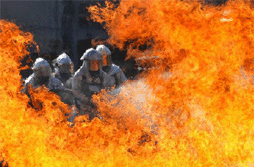Why Flames always look upward ?
Sakshi Education
What is a flame ?
 'Flame' is a region where atoms will be at very high temperatures. The chemical reaction that occurs between oxygen and fuel in the atmosphere around us forms a flame. Once the flame starts it burns by itself emitting heat, light, certain harmful gases and tiny splinters at high temperatures. Flame in fact is a system in gaseous state. For flame to burn the fuel in solid or liquid state should convert into gaseous state. Fuels in liquid state to change into a flame those liquids should first reach their boiling point and convert into a vapour. Fuels in solid state to form a flame should convert into vapour state by undergoing chemical decomposition.
'Flame' is a region where atoms will be at very high temperatures. The chemical reaction that occurs between oxygen and fuel in the atmosphere around us forms a flame. Once the flame starts it burns by itself emitting heat, light, certain harmful gases and tiny splinters at high temperatures. Flame in fact is a system in gaseous state. For flame to burn the fuel in solid or liquid state should convert into gaseous state. Fuels in liquid state to change into a flame those liquids should first reach their boiling point and convert into a vapour. Fuels in solid state to form a flame should convert into vapour state by undergoing chemical decomposition.
Flames always look upwards !
The cause for a flame to whirl upwards is the flame while burning heats up the air layers surrounding it. Due to this the density of that air decreases and becomes light and rises straight upwards. The pressure in the region around the flame decreases and the cold air away from the flame enter into that region. This air in turn will be heated up by the flame decreases in density and rises upwards. The speed of this rising hot air is more than the cold air that comes towards the flame. This process continues until the flame rises as described above, the flame along with that air rise upwards and thus the flames always look upwards.
Why flames emit colours ?
Little 'Physics'!! : The atoms of the burning fuels emit light energy. The electrons in an atom possess negative electric charge and are revolving round the centrally situated nucleus of the atom in different orbits. The nucleus of an atom is loaded with positively charged protons and charge less neutrons. Electrons will be possessing different energy levels. The electrons having more energy will be revolving in the orbits away from the nucleus.
When a substance is heated, the atoms of the substance will absorb the heat energy and the electrons in the atoms are excited. The electrons in the orbits nearer to the nucleus will migrate into the outer orbits of higher energy. But they cannot stay there for longer time because in the universe any object possessing energy will always try to release that energy. That is why the electrons that moved into higher energy levels try to fall back into their original energy levels. While doing so they will release the additional energy they obtained in the form of light energy. This light energy will be in the form of tiny packets called 'photons'. The energy possessed by a photon is called 'Quantum'. In German language Quantum means 'a small packet'. The colour of the light emitted by an electron depends on quantum energy. The quanta of different energy levels will have different colours.
This phenomena can be observed in the red, orange, blue colours emitted by a Bunsen burner flame in a laboratory.
 'Flame' is a region where atoms will be at very high temperatures. The chemical reaction that occurs between oxygen and fuel in the atmosphere around us forms a flame. Once the flame starts it burns by itself emitting heat, light, certain harmful gases and tiny splinters at high temperatures. Flame in fact is a system in gaseous state. For flame to burn the fuel in solid or liquid state should convert into gaseous state. Fuels in liquid state to change into a flame those liquids should first reach their boiling point and convert into a vapour. Fuels in solid state to form a flame should convert into vapour state by undergoing chemical decomposition.
'Flame' is a region where atoms will be at very high temperatures. The chemical reaction that occurs between oxygen and fuel in the atmosphere around us forms a flame. Once the flame starts it burns by itself emitting heat, light, certain harmful gases and tiny splinters at high temperatures. Flame in fact is a system in gaseous state. For flame to burn the fuel in solid or liquid state should convert into gaseous state. Fuels in liquid state to change into a flame those liquids should first reach their boiling point and convert into a vapour. Fuels in solid state to form a flame should convert into vapour state by undergoing chemical decomposition.Flames always look upwards !
The cause for a flame to whirl upwards is the flame while burning heats up the air layers surrounding it. Due to this the density of that air decreases and becomes light and rises straight upwards. The pressure in the region around the flame decreases and the cold air away from the flame enter into that region. This air in turn will be heated up by the flame decreases in density and rises upwards. The speed of this rising hot air is more than the cold air that comes towards the flame. This process continues until the flame rises as described above, the flame along with that air rise upwards and thus the flames always look upwards.
Why flames emit colours ?
Little 'Physics'!! : The atoms of the burning fuels emit light energy. The electrons in an atom possess negative electric charge and are revolving round the centrally situated nucleus of the atom in different orbits. The nucleus of an atom is loaded with positively charged protons and charge less neutrons. Electrons will be possessing different energy levels. The electrons having more energy will be revolving in the orbits away from the nucleus.
When a substance is heated, the atoms of the substance will absorb the heat energy and the electrons in the atoms are excited. The electrons in the orbits nearer to the nucleus will migrate into the outer orbits of higher energy. But they cannot stay there for longer time because in the universe any object possessing energy will always try to release that energy. That is why the electrons that moved into higher energy levels try to fall back into their original energy levels. While doing so they will release the additional energy they obtained in the form of light energy. This light energy will be in the form of tiny packets called 'photons'. The energy possessed by a photon is called 'Quantum'. In German language Quantum means 'a small packet'. The colour of the light emitted by an electron depends on quantum energy. The quanta of different energy levels will have different colours.
This phenomena can be observed in the red, orange, blue colours emitted by a Bunsen burner flame in a laboratory.
Lakshmi Emani
Published date : 26 Jun 2012 06:55PM
















